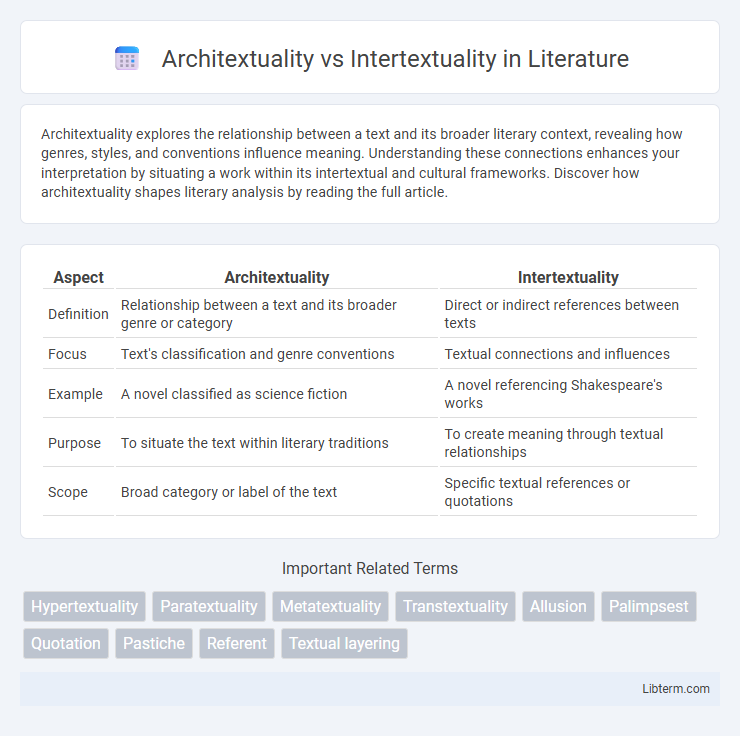Architextuality explores the relationship between a text and its broader literary context, revealing how genres, styles, and conventions influence meaning. Understanding these connections enhances your interpretation by situating a work within its intertextual and cultural frameworks. Discover how architextuality shapes literary analysis by reading the full article.
Table of Comparison
| Aspect | Architextuality | Intertextuality |
|---|---|---|
| Definition | Relationship between a text and its broader genre or category | Direct or indirect references between texts |
| Focus | Text's classification and genre conventions | Textual connections and influences |
| Example | A novel classified as science fiction | A novel referencing Shakespeare's works |
| Purpose | To situate the text within literary traditions | To create meaning through textual relationships |
| Scope | Broad category or label of the text | Specific textual references or quotations |
Understanding Architextuality: A Semantic Overview
Architextuality refers to the relationship between a text and its broader genre or category, highlighting how a work's meaning is shaped by its classification within literary traditions. This concept emphasizes the structural framework that informs a text's interpretation, differing from intertextuality, which centers on explicit textual references and direct connections between texts. Understanding architextuality enriches semantic analysis by revealing the implicit expectations and conventions that influence how readers decode and engage with a text's genre-based identity.
Defining Intertextuality in Literary Discourse
Intertextuality in literary discourse refers to the shaping of a text's meaning by other texts through direct or indirect references, quotations, or allusions. It highlights the interconnectedness of literary works and the influence of prior texts on the reader's interpretation. This concept contrasts with architextuality, which categorizes texts based on genre or overarching literary frameworks rather than specific textual relationships.
Key Differences: Architextuality vs Intertextuality
Architextuality refers to the relationship between a text and its broader genre, category, or textual classification, highlighting how a work aligns with or subverts expected conventions within its textual boundaries. Intertextuality involves the direct or indirect referencing, quotation, or influence of one text within another, emphasizing the dialogic interaction between distinct texts. The key difference lies in architextuality's focus on a text's classification and generic framework versus intertextuality's emphasis on explicit textual connections and influences across separate works.
Theoretical Roots: From Genette to Kristeva
Architextuality, rooted in Gerard Genette's narratology, emphasizes the relationship between a text and its genre or overarching textual category, defining the framework within which a work operates. Intertextuality, a concept pioneered by Julia Kristeva, explores the dynamic interaction between texts through references, quotations, and echoes that shape meaning beyond isolated readings. These theoretical foundations highlight distinct yet complementary pathways for analyzing textual relationships, with Genette focusing on structural classification and Kristeva on dialogical interconnectedness.
Functions of Architextuality in Textual Analysis
Architextuality functions as a critical tool in textual analysis by categorizing and defining a text's genre, thus guiding readers' expectations and interpretative frameworks. It reveals the relationship between a text and its overarching literary or discursive categories, which helps to situate the text within broader cultural and ideological contexts. By highlighting genre conventions and thematic affiliations, architextuality enhances understanding of how texts communicate meaning beyond intertextual references.
Manifestations of Intertextuality in Literature
Manifestations of intertextuality in literature include direct quotations, allusions, pastiches, and parody, enabling authors to create layered meanings by referencing or transforming existing texts. Intertextuality often appears through thematic echoes, narrative structures, or character archetypes drawn from earlier works, enriching the reader's interpretative experience. Unlike architextuality, which classifies texts within genres or literary categories, intertextuality actively engages with other texts to construct a dialogue across cultural and historical contexts.
Practical Examples: Architextuality and Intertextuality Compared
Architextuality classifies a text within a genre or category, such as labeling a novel as science fiction, while intertextuality involves direct or indirect references between texts, like a novel quoting or alluding to Shakespeare. A practical example of architextuality is marketing a book as a thriller, setting reader expectations based on genre conventions, whereas an example of intertextuality appears when a novel incorporates famous lines from another work to enrich its meaning. Understanding the distinction helps in literary analysis by differentiating between the text's overall genre framework and its specific textual connections.
Impacts on Reader Interpretation and Meaning-Making
Architextuality shapes reader interpretation by categorizing a text within specific genres or literary conventions, guiding expectations and framing meaning-making processes. Intertextuality influences understanding through explicit or implicit references to other texts, creating layered meanings and enriching the reader's engagement. Both concepts actively contribute to constructing a dynamic dialogue between texts and readers, deepening interpretive complexity and textual resonance.
Applications in Contemporary Literary Criticism
Architextuality examines the overarching genre and structural codes that frame a text, providing insight into its categorical identity within literary traditions. Intertextuality explores the dynamic relationships between texts through direct or indirect references, enriching the reader's understanding by highlighting influence, dialogue, and transformation. Contemporary literary criticism applies these concepts to decode genre conventions and interwoven textual networks, enhancing interpretations of narrative complexity and cultural interconnectivity.
Future Directions: Evolving Concepts in Textual Studies
Future directions in textual studies emphasize the evolving concepts of architextuality and intertextuality, exploring their dynamic interplay in digital media and multimedia narratives. Researchers focus on how architextual markers, such as genre conventions and paratexts, influence intertextual references across diverse platforms, enhancing meaning-making processes. Advancements in computational linguistics and machine learning enable deeper analysis of text relationships, driving new methodologies for examining textual networks and their cultural impacts.
Architextuality Infographic

 libterm.com
libterm.com